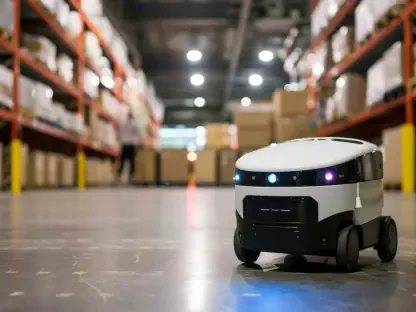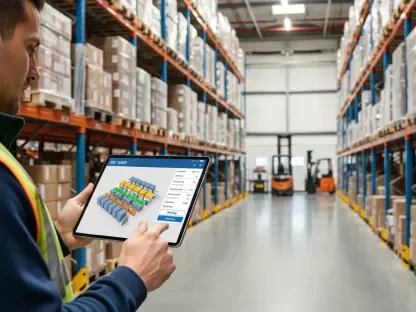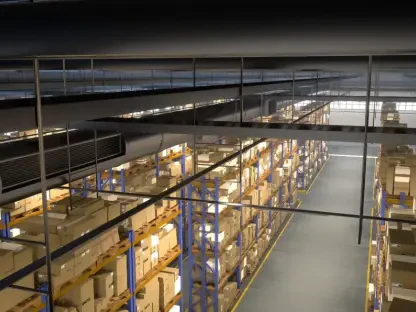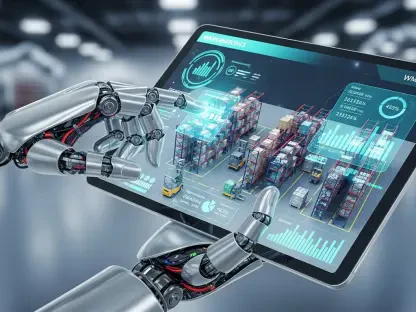In an era where technology drives efficiency across industries, the supply chain sector stands at a pivotal moment with artificial intelligence (AI) promising to revolutionize transportation management systems (TMS). Yet, despite the excitement surrounding AI’s potential, a significant number of organizations find themselves grappling with barriers that hinder seamless integration. Recent research surveying 150 senior decision-makers from diverse sectors such as manufacturing, retail, and consumer goods reveals a troubling gap between ambition and reality. While the allure of autonomous systems beckons, many companies face challenges that threaten to derail progress. From skills shortages to data visibility issues, the road to AI adoption is fraught with obstacles that could determine competitive standing in an increasingly digital landscape. This exploration delves into the core issues stalling AI implementation, shedding light on what holds the industry back from fully embracing transformative technology.
High Expectations Meet Harsh Realities
The vision for AI in transportation management systems is nothing short of transformative, with 63% of surveyed organizations expecting fully autonomous operations or minimal human oversight within the next five years. However, the current state paints a starkly different picture, as over half of these companies lack highly integrated AI solutions, and a concerning 18% report little to no adoption at all. This disconnect highlights a critical lag in readiness that could leave many businesses trailing behind more tech-savvy competitors. High implementation costs, cited by 55% of respondents, stand as a formidable barrier, often deterring investment despite the long-term benefits AI promises. Additionally, a lack of internal expertise, noted by 45% of decision-makers, compounds the issue, as teams struggle to navigate complex systems without adequate training or know-how. These challenges underscore a broader industry struggle to align lofty expectations with the practical limitations of current capabilities, raising questions about how to bridge this gap effectively.
Beyond financial and expertise constraints, organizational resistance further complicates AI adoption in TMS. A significant 43% of respondents point to insufficient executive support as a key hurdle, revealing a disconnect at the leadership level that stifles innovation. Without buy-in from top decision-makers, initiatives to integrate advanced technologies often falter, leaving teams without the resources or direction needed to succeed. This lack of commitment can create a ripple effect, dampening enthusiasm across departments and slowing momentum toward modernization. Moreover, the pressure to deliver immediate results often overshadows the long-term vision, as companies prioritize short-term gains over strategic investments in AI. The result is a fragmented approach to technology adoption, where ambition exists in theory but struggles to materialize in practice. Addressing these cultural and structural barriers will be essential for organizations aiming to keep pace with an evolving supply chain environment driven by digital transformation.
Data Visibility and Skills Gaps as Core Barriers
One of the most pressing obstacles to leveraging AI in transportation management systems lies in the pervasive issue of data visibility. Nearly half of the surveyed organizations, 49% to be exact, struggle to adjust shipping routes proactively due to inadequate access to real-time data, while 45% find themselves unable to prevent delays or disruptions through timely corrective actions. This limitation stems from fragmented datasets and siloed platforms, with 39% of respondents identifying these as significant impediments to seamless integration. Without a unified view of operations, AI tools cannot deliver the actionable insights needed to optimize performance, rendering even the most advanced systems ineffective. The inability to harness data effectively not only hampers day-to-day operations but also undermines confidence in AI as a reliable solution, creating a vicious cycle of hesitation and underinvestment that the industry must break to move forward.
Compounding the data challenge is a profound skills deficit within many organizations, as highlighted by 42% of respondents who cite a lack of technical expertise among their teams. This gap leaves companies ill-equipped to implement, manage, or optimize AI-driven systems, often resulting in wasted resources and missed opportunities. The complexity of modern TMS demands a workforce capable of navigating sophisticated tools, yet training programs and talent acquisition strategies have not kept pace with technological advancements. This shortfall is particularly concerning given the rapid evolution of AI, which requires continuous learning to remain relevant. Additionally, the absence of skilled personnel fosters a culture of dependency on outdated methods, further entrenching resistance to change. To overcome this barrier, a concerted effort to upskill employees and attract specialized talent will be crucial, ensuring that human capital aligns with the technological ambitions shaping the future of supply chain management.
Sustainability Concerns and Competitive Risks
An overwhelming 99% of decision-makers express deep concern that their current transportation management systems will fail to meet future demands for speed, capacity, or cost efficiency over the coming five years. This near-unanimous apprehension signals a critical need for investment in both technology and workforce development to keep pace with escalating expectations. Aging systems, unable to handle the complexities of modern supply chains, risk becoming liabilities as customer demands for faster, more reliable service intensify. The fear of obsolescence drives home the urgency of adopting AI, yet many organizations remain paralyzed by the very challenges that necessitate change. This paradox creates a pressing dilemmwithout modernization, companies face declining efficiency, but the path to innovation is riddled with financial and operational hurdles that test resolve and resources alike.
The competitive implications of failing to adopt AI are stark, with the potential to create a two-tier landscape where technologically advanced companies surge ahead while others lag behind. Industry experts warn that organizations unable to address internal skill shortages and dismantle data silos will struggle to unlock AI’s full potential, leading to higher costs and inefficiencies. This disparity could erode market share as customers gravitate toward providers capable of meeting evolving expectations with speed and precision. The risk of being outpaced by competitors underscores the need for strategic foresight, where investments in technology are paired with a commitment to organizational change. Companies that hesitate in the face of these challenges often find themselves at a disadvantage, unable to adapt quickly enough to shifting industry dynamics, as reflected in past adoption cycles.
Charting the Path Forward
Looking back, the journey toward AI integration in transportation management systems reveals a landscape marked by ambition but constrained by systemic challenges. Reflecting on the struggles with skills gaps and data visibility, it becomes clear that success hinges on targeted interventions. Organizations that tackle these issues head-on often prioritize comprehensive training programs to empower their workforce with the technical acumen needed for modern systems. Simultaneously, breaking down data silos through integrated platforms proves vital in unlocking actionable insights. Securing executive commitment also emerges as a linchpin, ensuring that innovation receives the necessary backing to flourish. Moving forward, the focus should shift to scalable solutions, such as partnerships with technology providers and incremental implementation strategies, to ease the transition. By addressing these foundational elements, the industry can transform past obstacles into stepping stones, paving the way for a future where AI drives efficiency and resilience across supply chains.









